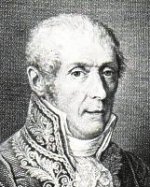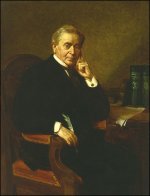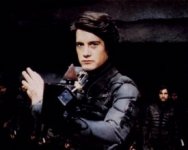Alessandro Volta (1745-1827)
Count Alessandro Giuseppe Antonio Anastasio Volta (1745-1827) was an Italian physicist known for the development of the electric battery.
Volta was born and educated in Como Italy, where he became professor of physics at the Royal School in 1774.
His passion had always been the study of electricity, and still a young student he had even written a poem in Latin on this fascinating new discovery, "De vi attractiva ignis electrici ac phaenomenis inde pendentibus". In 1775 he devised the electrophorus, a device that produced a static electric charge. In 1776-77 he studied gas chemistry, and devised experiments such as the ignition of gases by an electric spark in a closed vessel. In 1779 he became professor of physics at the University of Pavia, a chair he occupied for 25 years.
In 1800, as the result of a professional disagreement over the galvanic response advocated by Luigi Galvani, he developed the so-called voltaic pile, a forerunner of the electric battery, which produced a steady electric current.
In honor of his work in the field of electricity, Napoleon made him a count in 1810 and in 1815 the Emperor of Austria named him a professor of philosophy at Padua.
The electrical unit known as the volt was named in his honor.
Count Alessandro Giuseppe Antonio Anastasio Volta (1745-1827) was an Italian physicist known for the development of the electric battery.
Volta was born and educated in Como Italy, where he became professor of physics at the Royal School in 1774.
His passion had always been the study of electricity, and still a young student he had even written a poem in Latin on this fascinating new discovery, "De vi attractiva ignis electrici ac phaenomenis inde pendentibus". In 1775 he devised the electrophorus, a device that produced a static electric charge. In 1776-77 he studied gas chemistry, and devised experiments such as the ignition of gases by an electric spark in a closed vessel. In 1779 he became professor of physics at the University of Pavia, a chair he occupied for 25 years.
In 1800, as the result of a professional disagreement over the galvanic response advocated by Luigi Galvani, he developed the so-called voltaic pile, a forerunner of the electric battery, which produced a steady electric current.
In honor of his work in the field of electricity, Napoleon made him a count in 1810 and in 1815 the Emperor of Austria named him a professor of philosophy at Padua.
The electrical unit known as the volt was named in his honor.
Attachments
Err...is there a formula for that or was it spit out using PHerbs?
Did you just ask me what I was smoking? I don't drink and don't smoke (who knew?). It dulls the senses. In one of my "follow the links" web surfing adventures, I found a picture of Geog Simon Ohm's grave and saved it for a rainy day.
Lucid to a fault,
Fred Henry* Dieckmann
*http://www.si.edu/archives/ihd/jhp/index.htm
Washington is a pandamonium in which is congregated all the personifications of all the evil passions of the human character.
- Joseph Henry
It is a moral obligation that the present should acknowledge its indebtedness to the past, that it should transmit the knowledge which it has received, purified and increased, as a richer inheritance to the future.
- Joseph Henry
Did you just ask me what I was smoking? I don't drink and don't smoke (who knew?). It dulls the senses. In one of my "follow the links" web surfing adventures, I found a picture of Geog Simon Ohm's grave and saved it for a rainy day.
Lucid to a fault,
Fred Henry* Dieckmann
*http://www.si.edu/archives/ihd/jhp/index.htm
Washington is a pandamonium in which is congregated all the personifications of all the evil passions of the human character.
- Joseph Henry
It is a moral obligation that the present should acknowledge its indebtedness to the past, that it should transmit the knowledge which it has received, purified and increased, as a richer inheritance to the future.
- Joseph Henry
Attachments
IF THE SHOE FITS...
Phrankly I don't give a rats' *** what you smoke...
Now if you could find me a pickie of my favourite Ncolas Tesla?
Oh,BTW Phred shouldn't we play in the :Everything Else" section?
I already got a bit of a slap on the wrist for this....
Shall we Sir Diecks?
A vous l'honneur.
Phrankly I don't give a rats' *** what you smoke...
Did you just ask me what I was smoking? I don't drink and don't smoke (who knew?). It dulls the senses. In one of my "follow the links" web surfing adventures, I found a picture of Geog Simon Ohm's grave and saved it for a rainy day.
Now if you could find me a pickie of my favourite Ncolas Tesla?
Oh,BTW Phred shouldn't we play in the :Everything Else" section?
I already got a bit of a slap on the wrist for this....
Shall we Sir Diecks?
A vous l'honneur.
PHERBS
Hi guys,
By no means an expert on Pspice or anything else for that matter but I can't help wonder whether the discrepancies you seem to measure aren't due to a not so up to data database?
While trawling the web in the past months I couldn't help noticing that some sites offered updates of models and such.
Time to update perhaps?
After all there's no points comparing apples to pears?
Ta,
Hi guys,
By no means an expert on Pspice or anything else for that matter but I can't help wonder whether the discrepancies you seem to measure aren't due to a not so up to data database?
While trawling the web in the past months I couldn't help noticing that some sites offered updates of models and such.
Time to update perhaps?
After all there's no points comparing apples to pears?
Ta,
So the whole discussion was moved here? Such things can
only happen in cyberspice (whoops!!)
Frank,
You are cordially invited to find/create better models for certain
transistors if you can, but so far I haven't found any BJT models
on the net that are sufficiently close to the datasheets, nor
have I found any way it could be done with the current set
of Spice parameters. Certain things, like the soft transition from
saturation to on region or realistic beta droop simply seems
impossible to model. It seems PSPICE has added a parameter
that might help in the latter case, but I am not sure of that
since I don't use PSPICE, and I prefer models to be standard
SPICE, not vendor dependent.
only happen in cyberspice (whoops!!)
Frank,
You are cordially invited to find/create better models for certain
transistors if you can, but so far I haven't found any BJT models
on the net that are sufficiently close to the datasheets, nor
have I found any way it could be done with the current set
of Spice parameters. Certain things, like the soft transition from
saturation to on region or realistic beta droop simply seems
impossible to model. It seems PSPICE has added a parameter
that might help in the latter case, but I am not sure of that
since I don't use PSPICE, and I prefer models to be standard
SPICE, not vendor dependent.
THANKS BUT NO THANKS
Hello Christer,
It has been awhile since we talked and last time was a disaster ending.
My fault entirely so no probs.
My only concern was that perhaps some users didn't have their models kept to the latest specs.
Surely,discussing delicate stuff like this would be pointless under such conditions.
I feel that the creation of updates should be left to the makers of the software in colab with the industry, not the casual amateur.
Best regards,
Hello Christer,
It has been awhile since we talked and last time was a disaster ending.
My fault entirely so no probs.
My only concern was that perhaps some users didn't have their models kept to the latest specs.
Surely,discussing delicate stuff like this would be pointless under such conditions.
I feel that the creation of updates should be left to the makers of the software in colab with the industry, not the casual amateur.
Best regards,
Re: THANKS BUT NO THANKS
Don't think the disaster (was mainly a disaster for you, I think)
had much to do with us two discussing.
My only concern was that perhaps some users didn't have their models kept to the latest specs.
Surely,discussing delicate stuff like this would be pointless under such conditions.
I feel that the creation of updates should be left to the makers of the software in colab with the industry, not the casual amateur.
Best regards, [/QUOTE]
[/QUOTE]
Sure, improved models are sometimes released, but unless there
are plain mistakes in the first place, these updates are probably
minor compared to the inherent problems I am talking about.
Unfortunately, many of the interesting transistors for audio seem
not to have any Spice models available at all (maybe there are
for those who pay a fortune for PSPICE etc) so seems necessary
to DIY models for these. Actually, I don't think my models are
bad at all. I have tried to mimic important characteristics in the
datasheets as closely as possible, based on readin my old
book on semiconductor physics both forwards and backwards
ac ouple of times. However, any model must be a compromise
between different parameters, since it seems impossible to
model all behaviours correctly at the same time.
I think the semiconductor manufacturers are the ones who should
create and provide the Spice models. They have all the necessary
knowledge about the devices on the physics level and should
have the best chance of coming up with a good model. Besides,
one would assume they already have Spice models, or other
simulator models that could easily be converted to Spice, so it
would seem an obvious service to customers to privide such
models on the net. Some manufacturers do this, others seem
very reluctant, especially the japanese. I get a feeling that some
are afraid to do so since the models cannot be made good enough.
fdegrove said:Hello Christer,
It has been awhile since we talked and last time was a disaster ending.
My fault entirely so no probs.
Don't think the disaster (was mainly a disaster for you, I think)
had much to do with us two discussing.
My only concern was that perhaps some users didn't have their models kept to the latest specs.
Surely,discussing delicate stuff like this would be pointless under such conditions.
I feel that the creation of updates should be left to the makers of the software in colab with the industry, not the casual amateur.
Best regards,
Sure, improved models are sometimes released, but unless there
are plain mistakes in the first place, these updates are probably
minor compared to the inherent problems I am talking about.
Unfortunately, many of the interesting transistors for audio seem
not to have any Spice models available at all (maybe there are
for those who pay a fortune for PSPICE etc) so seems necessary
to DIY models for these. Actually, I don't think my models are
bad at all. I have tried to mimic important characteristics in the
datasheets as closely as possible, based on readin my old
book on semiconductor physics both forwards and backwards
ac ouple of times. However, any model must be a compromise
between different parameters, since it seems impossible to
model all behaviours correctly at the same time.
I think the semiconductor manufacturers are the ones who should
create and provide the Spice models. They have all the necessary
knowledge about the devices on the physics level and should
have the best chance of coming up with a good model. Besides,
one would assume they already have Spice models, or other
simulator models that could easily be converted to Spice, so it
would seem an obvious service to customers to privide such
models on the net. Some manufacturers do this, others seem
very reluctant, especially the japanese. I get a feeling that some
are afraid to do so since the models cannot be made good enough.
COMPUTOR MODELLING.
Hi,
Agreed.Bygones.
Your suggestion is correct,I believe that if more manufacturers would support programs like this,providing well averaged specs of their product they would benefit in the long run as well.
Problem is,there no such thing as long run anymore.
Or so it seems.
I know the feeling.
Probably due to the fact that you're playing at a higher level already.
Once you arrive at this level you're left to the elements and your own resources, lest you get lucky and meet someone who's been there and actually done it too.
Not quite likely.
One dead giveaway here are universities where you can assist in projects given the right contacts and if you're really lucky you can get a budget al to yourself.
At least in Europe,I haven't got a clue as to the hows and why's in other countries.
Too much said already,
Hi,
Don't think the disaster (was mainly a disaster for you, I think)
Agreed.Bygones.
Your suggestion is correct,I believe that if more manufacturers would support programs like this,providing well averaged specs of their product they would benefit in the long run as well.
Problem is,there no such thing as long run anymore.
Or so it seems.
Unfortunately, many of the interesting transistors for audio seem
I know the feeling.
Probably due to the fact that you're playing at a higher level already.
Once you arrive at this level you're left to the elements and your own resources, lest you get lucky and meet someone who's been there and actually done it too.
Not quite likely.
One dead giveaway here are universities where you can assist in projects given the right contacts and if you're really lucky you can get a budget al to yourself.
At least in Europe,I haven't got a clue as to the hows and why's in other countries.
Too much said already,
Hi guys,
Thanks Peter for giving the “spicy” discussion his own thread. As for me, don’t bother folks, I like to make a lot fun, don’t worry. And yes I like a good Côte du Rhone as well, preferably in a good restaurant in a small village in Bourgogne, France.
But building a good sounding I/V converter is not an easy task. It is worth a serious discussion not to be blown by a load of off-topic talk and chatting.
As for PSpice, here you can download a free student edition of a really good one. For DIY projects it has more than sufficient capabilities.
A year ago, I used pspice for investigating if it was worth the effort to replace the 2N3055’s in my 15W JLH Class-A amp by the far more linear MJL3281A. On-semi provides a good model for the 2N3055 as well. The hfe droop comes quite close to the datasheet. At first glance the MJL3281 showed indeed less harmonic distortion and stability was also no problem. The final mod gave indeed a sonically improvement.
Of course a simulation can’t tell you how the amp finally will sound, but is it fine to investigate the relative merits of what you are doing, dc set points, stability issues and slewing issues. You don’t need absolute numbers out of it. And your computer usually doesn’t turn in a pile of ash if something in the circuit goes terribly wrong, at least not mine.
By the way any one out there who has good models of the Hitachi lateral power MOS-fets? I am using the 2SJ79 and 2SK216 in my pre-amp for discrete single ended output op-amps with good results.
Thanks Peter for giving the “spicy” discussion his own thread. As for me, don’t bother folks, I like to make a lot fun, don’t worry. And yes I like a good Côte du Rhone as well, preferably in a good restaurant in a small village in Bourgogne, France.

But building a good sounding I/V converter is not an easy task. It is worth a serious discussion not to be blown by a load of off-topic talk and chatting.
As for PSpice, here you can download a free student edition of a really good one. For DIY projects it has more than sufficient capabilities.
A year ago, I used pspice for investigating if it was worth the effort to replace the 2N3055’s in my 15W JLH Class-A amp by the far more linear MJL3281A. On-semi provides a good model for the 2N3055 as well. The hfe droop comes quite close to the datasheet. At first glance the MJL3281 showed indeed less harmonic distortion and stability was also no problem. The final mod gave indeed a sonically improvement.
Of course a simulation can’t tell you how the amp finally will sound, but is it fine to investigate the relative merits of what you are doing, dc set points, stability issues and slewing issues. You don’t need absolute numbers out of it. And your computer usually doesn’t turn in a pile of ash if something in the circuit goes terribly wrong, at least not mine.
By the way any one out there who has good models of the Hitachi lateral power MOS-fets? I am using the 2SJ79 and 2SK216 in my pre-amp for discrete single ended output op-amps with good results.
Spice
"Of course a simulation can’t tell you how the amp finally will sound, but is it fine to investigate the relative merits of what you are doing"
Absolutely.....but not good distortion numbers.
2SK216
.MODEL M1Mod NMOS Level=1 AF=1 CBD=658P CBS=790P CGBO=852N
+ CGDO=22N CGSO=26.4N CJ=0 CJSW=0 FC=0.5 GAMMA=18.6 IS=250F
+ JS=0 KF=0 KP=80M LAMBDA=521U LD=0 MJ=.46 TOL=30% MJSW=0.5
+ NSS=0 NSUB=0 PB=.8 PHI=.75 RD=.84 RS=.84 RSH=0 TNOM=27
+ TOX=1E-7 TPG=1 UO=600 VTO=15
2SJ79
.MODEL M2Mod PMOS Level=1 AF=1 CBD=862P CBS=1.03N
+ CGBO=1.09U CGDO=48N CGSO=57.6N CJ=0 CJSW=0 FC=0.5
+ GAMMA=18.6 IS=250F JS=0 KF=0 KP=122N LAMBDA=1.04M LD=0
+ MJ=.46 TOL=30% MJSW=0.5 NSS=0 NSUB=0 PB=.8 PHI=.75 RD=.84
+ RS=.84 RSH=0 TNOM=27 TOX=1E-7 TPG=1 UO=600 VTO=-15
The sleeper awakes,
Paul Atreides
PS Anyone have a model for the weirding modules?
"Of course a simulation can’t tell you how the amp finally will sound, but is it fine to investigate the relative merits of what you are doing"
Absolutely.....but not good distortion numbers.
2SK216
.MODEL M1Mod NMOS Level=1 AF=1 CBD=658P CBS=790P CGBO=852N
+ CGDO=22N CGSO=26.4N CJ=0 CJSW=0 FC=0.5 GAMMA=18.6 IS=250F
+ JS=0 KF=0 KP=80M LAMBDA=521U LD=0 MJ=.46 TOL=30% MJSW=0.5
+ NSS=0 NSUB=0 PB=.8 PHI=.75 RD=.84 RS=.84 RSH=0 TNOM=27
+ TOX=1E-7 TPG=1 UO=600 VTO=15
2SJ79
.MODEL M2Mod PMOS Level=1 AF=1 CBD=862P CBS=1.03N
+ CGBO=1.09U CGDO=48N CGSO=57.6N CJ=0 CJSW=0 FC=0.5
+ GAMMA=18.6 IS=250F JS=0 KF=0 KP=122N LAMBDA=1.04M LD=0
+ MJ=.46 TOL=30% MJSW=0.5 NSS=0 NSUB=0 PB=.8 PHI=.75 RD=.84
+ RS=.84 RSH=0 TNOM=27 TOX=1E-7 TPG=1 UO=600 VTO=-15
The sleeper awakes,
Paul Atreides
PS Anyone have a model for the weirding modules?
Attachments
- Status
- This old topic is closed. If you want to reopen this topic, contact a moderator using the "Report Post" button.
- Home
- General Interest
- Everything Else
- Spice Empire



